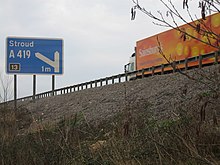
Back أميال الغذاء Arabic Food miles Catalan Food miles Spanish Jarak tempuh bahan pangan ID Ọtụtụ puku nri IG Chilometro zero Italian フードマイレージ Japanese 푸드 마일리지 Korean Voedselkilometers Dutch Food miles Portuguese

| Part of a series about |
| Environmental economics |
|---|
 |
Food miles is the distance food is transported from the time of its making until it reaches the consumer. Food miles are one factor used when testing the environmental impact of food, such as the carbon footprint of the food.[1]
The concept of food miles originated in the early 1990s in the United Kingdom. It was conceived by Professor Tim Lang[2] at the Sustainable Agriculture Food and Environment (SAFE) Alliance[3] and first appeared in print in a report, "The Food Miles Report: The Dangers of Long-Distance Food Transport", researched and written by Angela Paxton.[4][5]
Some scholars believe that an increase in the distance food travels is due to the globalization of trade; the focus of food supply bases into fewer, larger districts; drastic changes in delivery patterns; the increase in processed and packaged foods; and making fewer trips to the supermarket. These make a small part of the greenhouse gas emissions created by food; 83% of overall emissions of CO2 are in production phases.[6]
Several studies compare emissions over the entire food cycle, including production, consumption, and transport.[7] These include estimates of food-related emissions of greenhouse gas 'up to the farm gate' versus 'beyond the farm gate'. In the UK, for example, agricultural-related emissions may account for approximately 40% of the overall food chain (including retail, packaging, fertilizer manufacture, and other factors), whereas greenhouse gases emitted in transport account for around 12% of overall food-chain emissions.[8]
A 2022 study suggests global food miles CO2 emissions are 3.5–7.5 times higher than previously estimated, with transport accounting for about 19% of total food-system emissions,[9][10] albeit shifting towards plant-based diets remains substantially more important.[11]
The concept of "food miles" has been criticised, and food miles are not always correlated with the actual environmental impact of food production. In comparison, the percentage of total energy used in home food preparation is 26% and in food processing is 29%, far greater than transportation.[12]
- ^ Engelhaupt, E (2008). "Do food miles matter?". Environmental Science & Technology. 42 (10): 3482. Bibcode:2008EnST...42.3482E. doi:10.1021/es087190e. PMID 18546672.
- ^ http://www.city.ac.uk/communityandhealth/phpcfp/foodpolicy/index.html. He explains its history in this article Tim Lang (2006). 'locale / global (food miles)', Slow Food (Bra, Cuneo Italy), 19, May 2006, pp. 94–97
- ^ The SAFE Alliance merged with the National Food Alliance in 1999 to become Sustain: the alliance for better food and farming http://www.sustainweb.org/. Professor Tim Lang chaired Sustain from 1999 to 2005.
- ^ Paxton, A (1994). "The Food Miles Report: The Dangers of Long-Distance Food Transport". SAFE Alliance, London, UK. https://www.sustainweb.org/publications/the_food_miles_report/
- ^ Iles, A. (2005). "Learning in sustainable agriculture: Food miles and missing objects". Environmental Values, 14, 163–83
- ^ Weber, C.; Matthews, H. (2008). "Food-Miles and the Relative Climate Impacts of Food Choices in the United States". Environmental Science & Technology. 42 (10): 3508–3513. Bibcode:2008EnST...42.3508W. doi:10.1021/es702969f. PMID 18546681.
- ^ "Sources and Resources for 'Local Food: The Economics'". Worldwatch Institute. Archived from the original on April 4, 2019. Retrieved April 28, 2009.
- ^ Garnett 2011, Food Policy
- ^ "Climate impact of food miles three times greater than previously believed, study finds". The Guardian. June 20, 2022. Retrieved July 13, 2022.
- ^ Li, Mengyu; Jia, Nanfei; Lenzen, Manfred; Malik, Arunima; Wei, Liyuan; Jin, Yutong; Raubenheimer, David (June 2022). "Global food-miles account for nearly 20% of total food-systems emissions". Nature Food. 3 (6): 445–453. doi:10.1038/s43016-022-00531-w. ISSN 2662-1355. PMID 37118044. S2CID 249916086.
- ^ "How much do food miles matter and should you buy local produce?". New Scientist. Retrieved July 13, 2022.
- ^ John Hendrickson, "Energy use in the U.S. Food System: A summary of existing research and analysis." Sustainable Farming (Ste. Anne de Bellevue, Quebec), vol. 7, no. 4. Fall 1997.